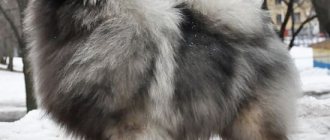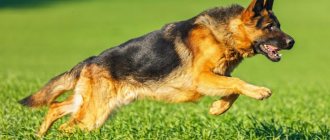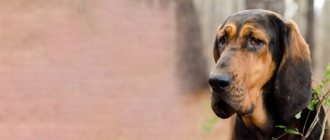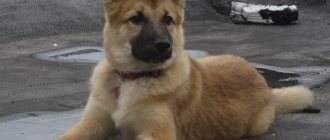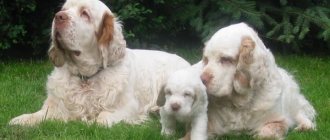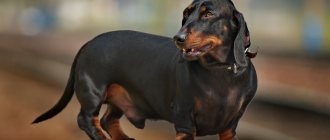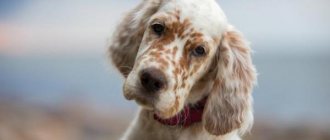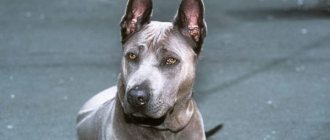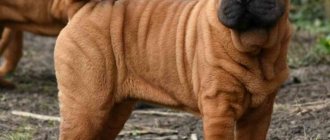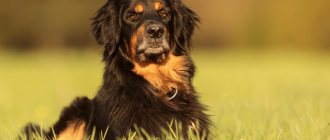Dogs (Canis lupus familiaris) are descendants of wolves and are classified as a subspecies of the gray wolf (Canis lupus). Foxes are omnivorous mammals belonging to several genera of the family Canidae. Because of their close genetic similarities, dogs and foxes share many physical traits. Tamed dogs are reliable pets and companions. Foxes are not suitable for keeping as pets. But if you like the look of foxes, you can choose a dog that looks like one. Here is a list of 10 dog breeds that resemble a fox.
Other breeds similar to foxes
There are other breeds that resemble red-haired forest dwellers:
- Spitz (Finnish, Pomeranian and German);
- Schipperke;
- Norwegian Elkhound;
- Welsh Corgi.
Schipperke
The black fox dog of the Schipperke breed was bred in Belgium and was originally used as a herding dog and for hunting rodents in barns and shops. These small shepherd dogs were considered good watchdogs. Now it is more of an ornamental breed.
The dogs are small, weighing no more than 9 kg. Height at the withers is from 28 to 32 cm. The color is exclusively black, the undercoat is thick, the guard hair is hard. The muzzle resembles that of a shepherd and a fox at the same time, the eyes are dark. The back is straight and strong, the paws resemble those of a cat with tightly pressed toes, the tail can be curled into a “donut” or hang down.
Schipperkes are not sofa decorations; they are active and inquisitive pets. The owner must be a partner in all games. Such dogs are not suitable for very young children; they will not allow themselves to be “squeezed.” They are also not suitable for the role of a nanny.
The owner must be very experienced; the Schipperke will more than once try to take the place of leader in the “pack”. At the same time, Schipperkes perfectly master even a complex training course. The Schipper just needs exercise, otherwise the dog will conflict with other pets, bully other dogs on a walk and attack guests. The dog needs to be constantly occupied, otherwise it will actively participate in the owner’s affairs.
Note! An ill-mannered pet can show aggression towards the owner and his family
Norwegian Elkhound
One of the symbols of Norway, the Elkhound is not quite a fox dog. Its other name is moose husky, so representatives of this breed are more like wolves. The color contains different shades of gray. The tips of the hairs are always dark.
The breed is ancient; the remains of Elkhounds have been found in Viking graves. Such dogs were used to hunt big game: moose, wolves, lynxes, bears. The character of Elkhounds is truly canine: they are loyal, friendly and affectionate pets with children. The Elkhound is a good watchdog, distrustful of strangers.
But there are also disadvantages. Dogs are noisy, without training they can be aggressive towards other animals and strive to control their owner. They often make independent decisions. Suitable exclusively for experienced and active owners.
Elkhounds are medium in size, weighing on average 22-25 kg, 49 cm is the average height of an Elkhound at the withers.
Pomeranian Spitz
Another small red dog that looks like a fox is the Pomeranian Spitz. These pets are very small, weighing up to 2 kg and height at the withers up to 22 cm. At the same time, their fearlessness does not correspond to their size; fluffy “oranges” will protect their owner to the last.
It takes a lot of time to care for fluffy red fur. Despite the fact that the dogs are decorative, they will not serve as decoration for the sofa. Pomeranians are constantly on the move and love active games and long walks. The Pomeranian Spitz does not have enough patience for small children, so if you have them, it is better not to get such a dog.
Note! A fox dog can easily train a weak-willed owner as needed. Therefore, Pomeranians are recommended for experienced dog breeders.
Pomeranian Spitz Filbert Mitch Boniface (Filka) – champion of Russia
Little German Spitz
The Small German Spitz is larger than the Pomeranian, reaching 28 cm at the withers. Average weight is 4-6 kg. During the molting period, the fluffy long coat needs to be constantly combed, at least once a day. The color can be different, including fox-red. The muzzle is pointed, the eyes and nose are dark, the ears are erect, the tail is ringed.
They are active and love to walk, but in bad weather they will be satisfied with the cat litter box. Most dog handlers do not classify these dogs as a separate breed, believing that they are one and the same with Pomeranians. But there are differences not only in size, but also in color, coat and tail shape.
Small German Spitz
Finnish Spitz are the most stubborn foxes
The second name for the Finnish Spitz is Karelian-Finnish Laika. They are excellent hunters and watchdogs. Height reaches half a meter at the withers. Average weight – 11-13 kg.
The muzzle is very similar to a fox, the nose is dark, the eyes are slanted and brown. The ears are set high and pointed. The coat is hard, quite long, and only variations in red color are allowed:
- dark orange;
- reddish red;
- red and gold.
Like many huskies, they do not tolerate heat well. The coat requires little grooming.
Korean Jindo
These natives of the South Korean island of Chingo in Korea are very athletic and hardy. They have been kept by islanders as hunters and companions for thousands of years, and were even given pride of place at the opening ceremony of the 1988 Olympic Games in Seoul.
These powerfully built dogs are available in almost any color: white, fawn, red and white, tan, light fawn, black, black and tan, gray and brindle. The Korean Chindo, with its red and white coat, is very similar to Asian red foxes. What they also have in common is a thick double coat, which helps them keep warm in cold winters.
Korean Jindos tend to be quite assertive, which can cause trouble for owners, but they enjoy spending time with their family. It is also worth considering that these are territorial dogs that do not tolerate other pets on their territory.
They require regular exercise or at least 30 minutes of brisk walks. With insufficient energy expenditure, these dogs can become stubborn. On the other hand, Korean Jindos are very smart, so they quickly learn new tricks.
Slugi and Saluki
Incredibly fast Arabian greyhound from North Africa. Outwardly, Slugi resembles an Azawakh: the same tall, lean, long-legged. Colors are shades of red, from light sand to reddish.
The slug's fur is so smooth, thin and short that it is almost invisible.
In Russia, purebred Slugs are rare. The only nursery operates in St. Petersburg.
Shorthaired Salukis.
Due to their external similarity and consonant names, the Slugi is sometimes confused with another Arabian greyhound, the short-haired Saluki. But DNA studies have proven that these are two separate breeds.
Corsican legends
For centuries, Corsican shepherds have told stories of strange animals that attack cows and sheep. These animals tried to attack the udders of livestock. There have also been attacks on chicken coops.
The unusual animal looked like both a cat and a fox. Legends about this animal have been passed down from generation to generation. The locals called it ghjattu volpe, which means “cat-fox” or “cat fox” in Corsican.
For a long time, scientists considered these myths to be fiction. It was assumed that Corsican peasants mistook ordinary cats for a new species of animal.
However, the fox cat does exist. In 2008, this animal was caught in a chicken coop in northern Corsica. The new species of mammal leads a predominantly nocturnal and secretive lifestyle. The cat-fox lives in remote and deserted places. That is why for many centuries it was impossible to catch it.
The foreman from “Parenthood” is married to a handsome man: photo
The Golden Monster and the Pterodactyl Phantom: 10 Strangest Scooby-Doo Villains
Taking care of your health and appearance: how a person can gain confidence
What to remember when choosing dogs
Buying a dog that looks like a fox should be done after all the characteristics of the pet have been studied. These animals have different features and characteristics and require different care.
Initially, you should decide for what purpose you plan to get an animal.
If there is a decorative interest, then you should pay attention to small breed dogs, such as Spitz. Larger animals are ideal for protection
Black Schipperke fox dog
Important! Basically, dogs that look like foxes have very thick and beautiful hair, so you should immediately understand that careful and high-quality care will be required. Otherwise, the pet will gradually lose its beautiful appearance and feel uncomfortable
Dogs that look like foxes are popular with many people simply for their appearance. However, such pets also have many excellent qualities for which they should also be appreciated and loved. Before choosing a breed, you should immediately decide on the purpose of the purchase.
Basenji
Known as the “no-bark dog ,” the Basenji is an ancient breed that has been around for 5,000 years. Her images can be found on many Egyptian artifacts, Babylonian and Mesopotamian art. After the collapse of these mighty civilizations, the Basenji returned to the wild until their hunting skills were reclaimed by African tribes living along the Nile and Congo rivers. Genetically, Basenjis remain the same as when they were first presented to the pharaohs as a gift. In the shape of their muzzle and ears they are very similar to foxes, although they cannot boast of thick fur.
These dogs are incredibly vocal and will howl until they have your full attention. Their voice is a unique sound, described as being similar to a yodel .
Basenjis are independent and aloof animals, but this does not affect their love for family. They are incredibly clean by nature and love to groom themselves, just like cats. Basenjis require tons of both physical and mental stimulation, becoming destructive when they get bored. Their high energy and sharp mind often get them into trouble.
Independence is a sign of the breed
The dachshund is characterized by an arched chest. The front legs are slightly bent at the joint, very strong. Gardeners who have dachshunds are amazed at how quickly they tear up mouse holes.
You need to raise a dachshund from three months. Smart dogs do not immediately learn commands. They respond well to encouragement and do not tolerate rude treatment.
He is wary of strangers and takes a long time to get used to strangers.
The dachshund is smart and can adapt to any conditions. She tries to rule, she is capable of mischief - tearing something out of spite. She doesn’t like to be held, this is due to physiological characteristics - the dachshund’s spine is weak. She constantly needs to move a lot and cover long distances.
Rules of care
Keeping fox-like dogs does not require much effort or expense. Their dense “coat” repels water and dirt. Animals are also characterized by cleanliness; they themselves are able to maintain the cleanliness of their fur, and in addition, they try not to get dirty. Grooming involves brushing with a stiff brush, the frequency depending on the length of the coat. For breeds with shorter hair, once a week is enough, while dogs with long hair should be brushed approximately once every 2-3 days.
If tangles have formed in the wool, they need to be carefully combed out. During shedding, the procedure should be carried out more often, since the densely pubescent undercoat sheds quite heavily, ideally once a week. Dogs are bathed rarely or when they are heavily soiled, using special shampoos. It is better to leave your dog's haircut to a professional. In terms of hygiene, you need to trim the hair between the toe pads and in the lower area of the tail.
Dogs' ears, eyes and teeth should be examined regularly: the ears are cleaned with a damp swab as they become dirty, and special toothbrushes and pastes are used to clean the teeth about 3-4 times a week. The animal's paws must be examined after each walk to avoid damage. Nails are trimmed approximately once a month.
Thick fur provides a good habitat for parasites, especially ticks. After each return from a walk, the coat is inspected for their presence. It is necessary to undergo regular veterinary examinations, vaccinations and anthelmintic prophylaxis.
In the past, almost all fox-like dogs were shepherds or hunters, so they love active pastime, long walks and physical activity. Due to their waywardness and too independent nature, animals simply need training and socialization. The classes will not be too difficult, since dogs are very smart and have a fairly developed intellect, but their stubbornness can become an obstacle.
Here you need to find the right approach to your pet. Such dogs need a confident owner with a strong character who can show his leadership. Otherwise, the animal will take on this role, and it will be impossible to control it.
Shiba Inu - a smart fox from Japan
Representatives of the Shiba Inu breed resemble foxes. They were bred in the Land of the Rising Sun specifically for hunting small game.
They look like foxes in their pointed ears, thick fur, coloring, narrow muzzle, and habits. They are distinguished by high intelligence, cunning, and quick wits.
Shiba Inus have rich facial expressions. These animals have extraordinary acting talent: they can portray any emotion and avoid punishment for their disobedience. Looking at the touching, guilty face, the owners forget about their recent intention to punish their pet.
Their resemblance to a fox and their talent as an actor are not their only advantages. They are loyal to their owner, good-natured and, like collies, can act as a nanny.
Longhaired Chihuahua
These miniature fluffy dogs are the smallest breed in existence. They appeared in Mexico in 1850. These dogs are available in almost all colors, but the long-haired red Chihuahua looks most like a dwarf fox.
Chihuahuas require minimal exercise and grooming, making them one of the most low-maintenance dogs. This is a good choice for older people .
Chihuahuas are eccentric, intelligent and incredibly loyal. They love to play with toys and be around family members, and their small size does not prevent them from fiercely protecting the people they love. It is worth noting that this breed is best suited for warm climates.
The most popular breeds with short legs
The total number of short-legged dog breeds reaches several dozen. Most of them have not been used for their intended purpose for a long time. High intelligence, devotion and small dimensions allowed the animals to easily move from hunting and herding breeds to the category of decorative ones. Among dogs with small paws, there are several species that have gained particular popularity.
Dachshund
Germany is considered the historical homeland of the long dog. Dachshunds were used to hunt badgers, rabbits or rats. Within the breed there is a division into long-haired and short-haired individuals. The popularity of dachshunds has not subsided for many years; they are kept in both country residences and apartments. Dogs get along well with other pets, are easy to train and easy to care for. Read more information about the breed here.
Pug
Bred in China, the dogs combine a thoughtful look and an adorable sniffle. Thanks to these qualities, dog breeders do not notice some of the difficulties in caring for this breed. Mostly, pug owners are faced with excess weight gain and poor thermoregulation. But these problems can be solved with balanced food, regular walks and additional insulation during the winter. In addition to its memorable appearance, the dog’s advantages include peacefulness and sincere affection for the owner.
Pembroke Welsh Corgi
A small, red, fox-like dog instantly brings a smile to completely different people. The favorites of the current Queen of England were originally used by the shepherds of Wales. By biting cattle on the legs, corgis guided the herds and prevented the animals from scattering. At the moment, the breed is experiencing a sharp surge in demand. And this is not surprising, given the unique combination of a memorable appearance with a playful disposition, which representatives of the breed retain until old age.
Welsh Corgi Cardigan
When talking about dogs with large furry ears and short legs, one cannot fail to mention a type of small shepherd dog. Funny and brave, Welsh Corgis have a high level of intelligence, easily learn various techniques and skills, and are unpretentious in care and maintenance. The breed is not at all characterized by aggression, so the dog will easily fit into a family with children and other animals. The love of games and increased activity of cardigans will not let the owner get bored for a minute.
Basset Hound
This breed of short-legged large dogs dates back to the 6th century, where they were specially bred for hunting. An aristocratic background, a sad, languid look and large floppy ears give them a special charm. Bassets have a strong and sometimes stubborn character. Therefore, it is recommended to begin training and education of representatives of this breed as early as possible. The dog's obvious advantages include lack of aggression, balance and loyalty.
English bulldog
The ancestors of the English bulldog are considered to be Roman Molossians, fighting baiting dogs. Thanks to their legendary ancestors, dogs are distinguished by their strength and endurance. These qualities made it possible to use dogs in fights with much larger animals. Fortunately, the days of harsh and bloody entertainment are long gone, and wrinkled faces now delight owners all over the world. The character of such a pet directly depends on its upbringing. There are both quite aggressive individuals and real gentlemen. More information about the breed can be read here.
French Bulldog
The powerful and stocky relative of the English Bulldog has erect ears and less pronounced folds on the muzzle. In addition to being used in improvised fights, dogs were used as rat catchers. The small size allows you to keep the animal at home. A dog of this breed is easy to socialize and trainable. He is moderately playful and will make an excellent defender.
Dandie Dinmont Terrier
A distinctive feature of this dog is its hairstyle, which is an Afro-style cap. The piercing gaze from under the lush bangs, long body and saber-shaped tail make the breed unusually attractive. The cuties have an iron character and require fairly tough training. The Dandie Dinmont's love and respect must be earned, and then the dog will respond with the most sincere devotion.
Scottish Terrier
The Scottish Terrier is a typical hunting dog bred in Scotland. It is distinguished by its muscular, flexible body, adapted for burrow hunting of small game. An important aspect is the correct and regular grooming of the animal. Due to this, the breed acquires a sophisticated and recognizable appearance. The Scots have a moderately stern character, but there are also playful individuals.
Volpino Italiano
Volpino Italianos are small Spitz-type dogs native to Italy. Despite their small size, they were originally kept as guard dogs. These Florentine Spitz are very energetic and playful . The Volpino Italiano's job used to be to warn large mastiffs about an intruder.
These decorative miniature white dogs are very similar to polar foxes; the white and red Volpino Italiano resemble miniature common foxes.
For some unfortunate reason, the Italian Volpino almost became extinct in 1965. At that time, there were only five representatives of the breed left. But efforts to protect them have been very successful, and in 2006 there were already about 2,000 individuals. However, the Volpino Italiano is still a rare breed of dog .
Most Florentine Spitz dogs are found in Italy, but they are also bred in Scandinavia, the UK and the USA. Currently, the breed is registered in most well-known kennel clubs.
Pros and cons of small dogs
Even though these dogs are quite small, you need to be prepared for anything.
Advantages
It is quite natural that a small dog, compared to a large dog, will eat much less food in the same period of time, so having a small dog in the house can save significant money. In addition, a small dog does not need much living space. After walks, and in the process of life, a small dog produces a minimum of hair, dust and dirt.
When going shopping at the store or going out of town to the country, as well as in other cases, such a pet can be placed in a handbag, where this four-legged friend feels very comfortable. If you raise such a companion correctly, then he will be friends with other pets, with small children, and they are not so aggressive towards strangers.
An important factor is life expectancy. With proper care, decorative dogs can live about 2 decades, although similar longevity records are also typical for medium-sized dog breeds.
Flaws
Many indoor dog breeds are serious pets that require training and education. Unfortunately, many owners of decorative dogs do not realize this. The same can be said about small hunting dogs, whose behavior is not so flexible. Some breeds of small dogs have increased activity and excitability, which must be directed in the right direction through training. Increased excitability against the background of high muscle activity leads to noticeable energy expenditure, which must be compensated through diet.
The difficulty of feeding such pets also lies in the fact that they quickly get used to one type of food, which is sometimes quite harmful. If you start feeding an animal with sausage or chicken legs, it is unlikely that the dog will be able to switch to feeding other food, unless under the threat of starvation. Owners of such animals will have to face a number of other behavioral problems. These animals follow their owners or other family members literally on their heels. Due to this fact, many of them fall under the feet of their household members, receiving injuries of varying severity.
Some small artificially bred dog breeds are susceptible to various congenital pathologies that are associated with:
- Dislocation of the kneecaps.
- Necrosis of the femoral head.
- Not overgrown fontanel.
- Absence of teeth or presence of 2 rows of teeth. Predisposition to tartar.
- Various allergic reactions.
Dogs that are trained to use a litter tray begin to mark corners as they age if they are not walked for a long time. A sharp and unpleasant odor also appears. This problem can be solved through castration, but the most humane and effective method is considered to be regular walking of your pet.
Top 10 most popular small dogs\Top 10 most popular small dogs
Watch this video on YouTube
Norwegian Gray Elkhound
Photo: ChildofMidnight at English Wikipedia
The Norwegian Gray Elkhound is a hunting dog breed, but also belongs to the Spitz group. This is a playful dog, but at the same time it is a good guard and a loyal pet. The Norwegian Gray Elkhound needs to be socialized with people. Therefore, during prolonged separation and loneliness, the dog may develop behavioral problems. Despite their small stature, the Norwegian Gray Elkhound is an extremely energetic breed that requires daily exercise.
Medium dogs
English cocker spaniel
Hardy hunting breed. Loves walks in nature, but can live in the city with sufficient exercise.
Height does not exceed 41 cm, weight – 15 kg. The English Cocker Spaniel loves children and is always ready to protect its owners.
He learns quickly and willingly wears clothes.
You need to regularly comb the dog, trim the hair between the toes, pluck the hairs on the face, and clean the ears if they get dirty with food.
The English Cocker Spaniel is the very embodiment of fun and good nature
West Highland White Terrier
The dimensions of an adult dog do not exceed 30 cm, and weight – 11 kg. However, the white terrier is strong and tireless.
The dog can be kept in an apartment, but needs good exercise - walks, games.
Not suitable for small children. Thick, coarse coat requires brushing.
Twice a year, the West Highland White Terrier is trimmed and clipped, including with a clipper.
A duo of West Highland White Terriers perform a Christmas bark for guests
Scottish Terrier
The Scottish Terrier is always included in famous dog breeds.
The dog today is more decorative (weight up to 10-11 kg, height up to 29 cm), but initially its ancestors were used for hunting.
The Scottish Terrier is smart, loves children - plays and protects.
The dog's fur does not fall out on its own; the breed standard requires trimming and cutting twice a year.
The cute Scottish Terrier is a hardy dog with a determined and persistent character.
Shar Pei
A stately dog originally from China, invulnerable thanks to its tough coat and folds of skin. Height is up to 50 cm, weight can reach 25 kg.
When a Shar Pei finds itself in a family as a child, it is forever devoted to its owners. A good guard, a friend of children.
Will respect an owner with a strong character. Staying alone, he doesn’t spoil things, he’s calm.
It is important to take daily walks and exercise your dog well.
“If you go on a visit and carelessly take your Shar Pei with you, don’t be surprised that you simply won’t be noticed.”
American Eskimo Spitz
A standard Spitz grows up to 48 cm and can weigh up to 17 kg.
The breed originated from German Spitz dogs brought to America.
This is an excellent choice for the city - the dog is smart, well trained, obedient, playful and affectionate, vigilantly guards the family and children. Thick coat with dense down needs to be combed, but washing the dog frequently is not recommended.
In winter, the Pomeranian benefits from snow baths.
What is so interesting that the American Spitz is whispering to this attentively listening angel?
Miniature Schnauzer
A strong dog up to 50 cm tall and weighing up to 19 kg. In the old days, miniature schnauzers helped in hunting and guarded houses.
A loving friend, a faithful companion and protector, a nanny for children - this is what a mittel is today.
Smart, courageous, quickly learns commands. The Miniature Schnauzer requires training from childhood.
It does not shed, so it needs to be scratched and trimmed in autumn and spring.
Miniature Schnauzer - winner of the best dog bangs competition
Sheltie
Similar to a fox, the Shetland Sheepdog or Sheltie reaches a height of 40 cm and a weight of 11 kg.
The dog is very smart, not aggressive, loves to learn commands, and is trainable.
Loves walks, like the Greyhound, loves to run. Sheltie is very affectionate with children, caring as well as a mother.
The long, thick wool has a high fluff and is suitable for spinning. The dog needs to be brushed often, especially during the coat change period.
Amazing Shelties can smile with all forty-two teeth
Basset Hound
A massive (height up to 38 cm, weight up to 27 kg) and seemingly clumsy dog with large ears and a huge nose.
The character is calm and balanced. The Basset Hound always becomes a full-fledged member of the family, loves children very much, and patiently endures games and pranks.
Without education, he can be willful. Grooming is easy, but when the dog sheds, you will have to brush it often.
The Basset Hound has a memorable appearance due to its long ears and sad-melancholy expression on its face.
Chow chow
Chow chow comes from China. Known for its resemblance to a bear cub, blue tongue and the fact that people in Asian countries are not averse to eating it.
Surprisingly clean, easily litter trained.
An excellent guard and watchman, but almost never barks.
The dog’s luxurious coat needs to be washed and combed, and the hair between the toes must be trimmed. Eyes are wiped daily.
Chow Chow - a dog with creative abilities
Bull Terrier
The Bull Terrier is a fighter bred in England. Included in the medium dog breeds. The dog's height should not exceed 46 cm, and its weight should not exceed 30 kg.
Has strong, sculpted muscles and powerful jaws
It is important to prohibit aggression towards other dogs and strangers from an early age.
The dog is playful, active, unpretentious in maintenance, but walks with good exercise and games are required.
The fur sheds twice a year. A rubber mitten is suitable for combing.
The Bull Terrier is a world-famous traveling dog.
Japanese Spitz
The breed likely originated from a mix of a white German Spitz and a white Keeshond from Canada that were imported to Japan around the 1920s . These beautiful dogs bear a striking resemblance to arctic foxes; they feel at home both in a small apartment and in a spacious country house.
The Japanese Spitz is always up for an adventure, whether it's a run on the beach, a hike in the forest, or a long car ride.
Japanese Spitz are intelligent, friendly, loyal and loving pets. They learn very quickly and often smile , especially during fun walks and active games. These are one of the most active and playful pets.
Puppy price and tips on how to choose
Experienced dog breeders advise purchasing puppies at the age of two months. Babies no longer need breastfeeding or constant maternal care. They have received the required vaccinations.
When choosing a future pet, you should definitely pay attention to:
- on the puppy’s appearance (clean ears, eyes, absence of an umbilical hernia);
- on the mother’s appearance (an unhealthy-looking and unkempt animal is unlikely to have good offspring);
- on the puppy’s behavior (it is better to give preference to an active and active baby);
- on the conditions of keeping animals.
Several factors influence the cost of a puppy. Puppies sold at markets are usually inexpensive. But going to this place for a dachshund, there is a big risk of buying a pig in a poke. There is no guarantee that the animal is clean, meets the standard, or has a balanced psyche.
The price of a puppy from a kennel starts from 10 thousand rubles. The better the pedigree and the more titled the parents, the higher the cost.
Keeping at home
These foxes have thick fur, but it is not very long and easy to care for.
The animals themselves are very active and playful, they love to constantly run and look for something, while jumping onto the sofa, bedside table and even the windowsill without any problems. They also know how to talk: barking, snorting, whining, grumbling and even howling - all this is in their sound arsenal. The diet of a fox is similar to that of small dogs:
- meat (chicken, veal, rabbit, lamb);
- fish (only boiled or frozen, without bones);
- vegetables and fruits (the first ones should be boiled).
Like cats and dogs, your pet Phoenix can be trained to go to the toilet on a special tray or in a diaper.
Andalusian maneto
Spanish primitive hunting dog. Outwardly similar to its ancestors, the Andalusian Podengo, only the limbs are much shorter.
Height at the withers is 30 – 35 cm. The coat is thick and close-fitting. Colors – all shades of cinnamon, white. In Spain, Andalusian maneto are kept by hunters and farmers, but can also be found in cities. The breed is not registered in the FCI, although it is under consideration by the Royal Canine Society of Spain.
Long, short-legged dogs, regardless of breed, are well suited for home keeping. However, they have different temperaments, levels of mobility, and learning ability, so each needs its own approach.
Varieties
Fox-like dogs come in different sizes: large, medium and small. All of them have both common characteristics and purely individual ones.
Collie
Long-haired collies reach a height of 60 cm and a weight of 30 kg. With such parameters, they are distinguished by grace and harmonious physique. In the past, animals were used as shepherds or working dogs, but now they are considered decorative.
The resemblance to a fox is enhanced by its elongated head, almond-shaped eyes, as well as a fluffy collar and tail. Thanks to the dense undercoat, the collie's coat is thick, the color is mainly sable, with shades of yellow, red and light golden tones.
They also resemble a cunning fox in their intelligence. Scottish Shepherds are unpretentious in care, but they are distinguished by their endurance and calm character.
They treat children with special attention and affection, being amazing nannies.
Samoyed
One of the most ancient breeds that lives in the north. Representatives of the breed served as sled dogs, as well as hunting and guard dogs. They can weigh up to 25 kg, and the height of an adult dog is up to 57 cm. The Samoyed is characterized by its great similarity to a white fox, not only by its strong, somewhat elongated build and coat color. They have a similar head shape - a wedge-shaped, slightly elongated muzzle, small triangular erect ears and slightly slanted eyes.
In addition, they are similar in the structure of their coat; in both animals it is two-layered, with a dense white or cream collar. Although the Samoyed's character is quite stubborn and independent, it can be easily corrected with proper upbringing and attention from the owner.
The breed is not at all characterized by aggression; they are extremely friendly and patient with children.
Norwegian Elkhound
It belongs to ancient hunting breeds and is characterized by its similarity to the silver fox. The dog's ears are triangular, straight, and its fur shimmers in shiny black and gray shades. Despite its endurance and northern temperament, the Elkhound has a gentle character. He is distinguished by his friendliness, intelligence and good attitude towards children . The negative aspects of the breed include excessive independence and the desire to dominate, as well as aggression towards other animals.
Representatives of this breed require training and socialization, otherwise they will become uncontrollable.
Shiba Inu
A Japanese hunting breed that was used for catching small game. Today, the dog has turned into a friendly companion and family pet, having lost its original purpose. Shiba Inus belong to medium-sized breeds; they can reach a height of 41 cm and weigh up to 12 kg. The dogs are playful and energetic, but unpretentious in their maintenance. By its nature, the animal is quite self-confident, and this feature can become a problem for an inexperienced or too soft owner.
To get obedience and respect from a dog, you need to give it a lot of time and attention.
Keeshond
The dog belongs to the Spitz variety. Previously, she was kept as a guard, but now she is acquired as a companion. The maximum height of the animal reaches 45 cm. According to external data, the Keeshond resembles a silver fox. The head is wedge-shaped with a slightly elongated, rectangular muzzle.
The dogs are quite independent, but very peaceful. They get along well with other animals, particularly cats, and adore children. The breed is easy to train because it has high intelligence and curiosity.
American Eskimo Spitz
Its appearance is very similar to a white fox. The fluffy coat, pointed muzzle and sly look give a great resemblance. Dogs come in three varieties depending on their height: standard, miniature and toy. Representatives of the breed are distinguished by their well-developed intelligence, attentiveness and active disposition. In addition, they are very loyal and excellent guards.
The dog needs physical activity, and also needs to devote quite a lot of time to it.
Sheltie or Shetland Sheepdog
It is characterized by medium size, the Sheltie's height is on average 35-40 cm, and its weight is about 10-12 kg. In addition to its characteristic resemblance to a fox, it also has thick fluff, the color of which can vary from sable to a combination of brownish, red and white.
The sly look of slanted eyes also gives the dog a resemblance to a fox. The Sheltie is distinguished by excellent health, well-developed intelligence and high performance. In the past they were shepherds, but now they are exclusively decorative dogs, they are friendly and sociable.
Their character is calm and peaceful; their graceful posture gives the Sheltie a certain aristocracy.
Schipperke
A small shepherd that resembles a black fox. The breed combines the characteristics of a Spitz and a fox. The average height of a dog is about 30 cm, and its weight reaches 7 kg. The animals are very active and inquisitive, with a calm character. Dogs can spend a lot of time with children; they love to play and indulge.
Finnish Spitz
Very reminiscent of a fox, even has a similar look. In addition to golden-red fur, it can have a dark gray, black or brown color, as well as fawn and black. The breed belongs to the hunting breed and was used for baiting both birds and much larger animals such as wild boar or bear. It can reach 50 cm in height.
Due to his independent and independent nature, he needs a strict owner, as well as intense physical activity.
Pomeranian Spitz
A representative of this breed only acquires the features of a fox with age. The color of dogs can be different: from red and golden-red to blue and black. They weigh on average up to 3 kg with a height of about 20 cm. The dogs are distinguished by their intelligence and activity. Self-confidence and courage often leads to fights with other dogs, even if they are significantly larger in size.
The Spitz needs daily active walks and regular training.
Welsh Corgi
A breed of small dogs with short legs and large ears. Adults can reach 25-30 cm in height and weigh up to 12 kg. Corgis are characterized by a good disposition and a reverent attitude towards their owner.
Despite their squat paws, dogs love energetic games and long walks. Their balanced nature makes them wonderful companions.
Pomsky
A hybrid of a Pomeranian Spitz and a Husky, the breed is quite young, not yet very popular and little studied. Depending on the characteristics of the parents, they can have different colors and parameters. Dogs are energetic and inquisitive. They love active games and walks. Their character is non-aggressive, but they love to bark. Of all the members of the household, the Pomsky will choose his favorite and will obey only him.
Other types
In the canine literature, types of dachshunds are distinguished depending on their size. In this case, the main parameters are taken into account:
During the selection process, 3 groups of animals emerged and were named:
Ordinary adult individuals are characterized by average sizes: height 0.2-0.27 m, body weight up to 9 kg, chest volume 35 cm. The dwarf type is somewhat smaller: height 0.14-0.21 m, weight 4-5.5 kg , chest girth 30-35 cm. Rabbit dachshunds belong to the category of mini pets. Their height at the withers does not exceed 0.15 m. Mature animals weigh approximately 3.5 kg. The chest reaches a volume of up to 30 cm.
Dogs of standard sizes have full hunting properties; small varieties were bred for decorative purposes. They do an excellent job as pets. Miniature dachshunds appeared on Russian territory at the end of the 20th century.
Description of the decorative fox Fennec
Today we will talk about an unusual representative of the canine family - the little Fennec fox, which is increasingly being kept as a pet.
A cute face, curious eyes and big beautiful ears are what attract people’s attention to these animals.
Their natural habitat is the deserts of North Africa, but their tiny size makes them an excellent alternative to small dog breeds for apartments. The height at the withers of the Fennec fox ranges from 18-22 cm, the body length is about 30-40 cm, and the total weight is only up to 1.5 kilograms.
Prices for domestic Fennec fox
Although the Fennec fox is small in size, the price of this pet is quite considerable - about 150 thousand rubles (2 thousand dollars) per puppy.
- Nursery in Moscow - “Exotic Family” www.exotic-family.com
- Nursery in Kyiv - unknown;
- Nursery in Minsk - unknown.
American Hairless Terrier
These dogs appeared among their hairless counterparts relatively recently - in 1972 as a result of a genetic mutation. Their dimensions average 40 cm and weigh up to 7 kg. Dogs are considered long-livers: their life span often reaches 15-16 years. They have a developed chest and a powerful shoulder girdle, as well as a graceful posture.
Americans often have white skin with a black muzzle and spots along the body; it is soft compared to other dogs. At the same time, the color of animals can be varied. In nurseries you can purchase such animals with plain and contrasting colors in the form of spots.
By nature, these dogs are cheerful, they are extremely inquisitive and sociable, although they do not show it outwardly. Unlike Peruvians, who prefer to be nocturnal and sleep during the day, these creatures are able to adapt to the rhythm of life of their owners. They prefer owners with a strong core, whom they are ready to obey unquestioningly. American Hairless dogs have a sense of self-esteem, they have developed intelligence, and therefore they do not growl or attack unnecessarily.
In terms of their level of activity, they are often compared to children: these pets have more than enough energy, and some owners consider their dogs to be real bullies. Some people consider them tame because they get along well with everyone in the household and love to play with children. Despite their apparent carelessness, dogs are very responsible, and therefore cope well with the role of a nanny. However, representatives of the breed also have disadvantages.
For example, in addition to the often painful gastritis, these dogs know firsthand what frostbite and sunburn are. Their skin is very delicate, it sweats a lot, which leads to irritation and itching. The nails of these dogs grow slowly: they need to be cut no more than once every 3-4 months. The eyes are distinguished by a large release of moisture, which is why they are regularly wiped with a cotton swab.
Schipperke
Schipperki are actually much smaller than they seem - only up to 33 cm in height and up to 7.3 kg in weight. These small dogs started out in Belgium as hard-working ship's dogs , bred to catch rats and look after valuable cargo.
These dogs hunted in a distinctive cat style and were popular among ship crews, earning them the Flemish name "schipperke" or "little captain".
Schipperkes are fearless, loyal and make excellent guard dogs. However, these beautiful pets can be quite independent and mischievous, so plenty of activity and training is needed to meet their needs.
Story
Throughout its existence, the main purpose of the dachshund was hunting. It is believed that modern representatives descended from ancient hounds. Short dogs, considered a waste among their relatives, became the ancestors of dachshunds.
At first there were only two species - dogs for underground hunting with bowed legs and hounds with coarse hair. The growing popularity of dogs gave impetus to the breeding of other species that differed from each other in their coat type.
The first attempts to create dogs with a hard coat were unsuccessful. Only towards the end of the 19th century. managed to achieve the desired result. Pinschers, terriers, and schnauzers took part in the selection. At the same time, the first standard appeared.
In Russia, the breed was not in demand for a long time. It is known that A.P. Chekhov and actress N.E. Ermolova were admirers of these dogs. Dachshunds became widespread in the middle of the last century. Now the breed is popular both for its working qualities and for its individual, interesting character.
Alaskan Klee Kai
The Alaskan Klee Kai breed originated in the 1970s as a smaller version of the Husky. This intelligent, playful and extremely energetic dog makes a wonderful and loyal pet. The Alaskan Klee Kai loves its family members, but will be more wary of strangers. Although these dogs can be found in a variety of colors, the rare red and white Alaskan Klee Kai bears a striking resemblance to the red fox.
Papillon
The real decoration of the Papillon, or Continental Toy Spaniel, is its ears, open like the wings of a butterfly. These are very active and cheerful dogs that require only one thing from the owner - attention to their person. They will reward you with devotion and even, one might say, care, because their older friend becomes the center of the universe for them. Papillons easily adapt to any living conditions and are quite loyal to children.
Papillons not only remember commands well, but are also able to understand the meaning of other words that make up the owner’s active dictionary
You should not be fooled by the fragility of the Papillon when raising it. This breed requires moderate severity, otherwise a cute puppy will grow into an aggressive and capricious creature that will rule the lives of its owners.
Height at the withers usually does not exceed 28 cm, and weight ranges from 1.5 to 5 kg, which allows this dog not only to comfortably complement the life of a family in a small apartment, but also to accompany its owners almost everywhere.
Basset Hound
The breed originated in France but developed in Great Britain. The ancestors of the Basset Hound were the Artesian-Normandy Basset.
The height of English basset dogs is 33 – 38 cm.
They are short dogs with large floppy ears. When running, they flutter in the wind; when calm, they resemble drooping wings. The skin on short massive limbs gathers in folds.
Calm, good-natured Basset Hounds love comfort, but remain hunters at heart. If they “catch” a fascinating smell on the street, they react poorly to the owner’s call and forget about everything in the world. A characteristic feature of English basset dogs is a sad expression on their face, regardless of their emotional state. Owners determine the mood of their pets by their tail.
Pembroke Welsh Corgi
Representatives of this breed have a funny appearance: large, erect ears and short legs. They have two types of main colors - red and white and multicolor. The first assumes that the main color tone of the body will have a fawn or deep red tint with white spots located in different parts of the body.
You need to know that the standard allows white markings of any size, provided that they are on the face, head, paws and neck. The ears must have a rich red tint. White spotting on the body is not desirable. The second color is possible with a combination of black, orange and white. Moreover, red-and-white puppies are not born fiery red immediately, but go through a stage of recoloring. Tricolor puppies lose their rich coat color as they age.
What to feed?
The main requirement for the diet of fox-like dogs is that it must be balanced and of high quality. Animals do not make any special demands, but you should not mix different types of food, or give food from the table. The diet should consist of:
You should not feed your pet bones, river fish, pork, flour products and sweets. From time to time you can give raw vegetables to chew; they perfectly clean tartar. The meat is given scalded or lightly boiled, and the porridge is cooked in meat broth or water. When choosing dog food, you need to focus on premium nutrition. It is recommended to give food 15-20 minutes after the walk.
Puppies need to be fed 4-5 times a day, and from 6 months they need to be fed 3 times a day, indicators may vary depending on the breed. Adult dogs should be fed twice a day.
It is recommended to feed the animal at certain hours. The water in the drinking bowl must be constantly fresh and clean.
About a dog that looks like a fox, see the following video.
Source
Why is crossing impossible?
Despite the persistent myth about the existence of mixed foxes and dogs, scientists give a definite answer: they do not exist. There are several reasons for this:
- The behavior and physiology of dogs and foxes are very different, so they will not be able to accept each other as “one of their own” and establish close contact.
- Even if a dog and a fox live next to each other for a long time (in a zoo or as pets), and mating occurs, conception will not occur. These species have a large difference in the number of chromosomes (for example, the red fox has 34, and the dog has 78). Biologically and genetically, the fox is far from both the dog and the wolf. The differences are so great that foxes are classified as a separate genus, Vulpes, while wolves and dogs belong to the genus Canis lupus.
Careful research by scientists (G. Natuizus, A. Kühn and others) back in the century before last confirmed the impossibility of the appearance of such mestizos. And the similarity of some dogs to foxes is purely external. Nature is amazing, and external resemblance does not always mean close relationship.
It may seem that Maya is a dog-fox hybrid, but in fact her parents are a husky and a Pomeranian.
There is no mixed breed between a fox and a dog, since these animals are too different physiologically and genetically. Their natural crossing is impossible. But maybe someday scientists will breed foxcats artificially.
